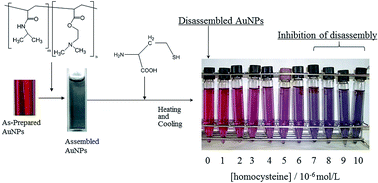Colorimetric assay of homocysteine using gold nanoparticles conjugated with thermoresponsive copolymers†
Abstract
Homocysteine was distinguished from cysteine and assayed by colorimetry with gold nanocomposites composed of 13 nm gold nanoparticles conjugated with thermoresponsive copolymers, poly(N-isopropylacrylamide-co-2-(dimethylamino)-ethylmethacrylate). The colorimetric assay of homocysteine was based on the disassembly of the assembled gold nanoparticles due to conjugation with the thermoresponsive copolymers. Heating followed by cooling a solution of the gold nanoparticles induced the phase transition of the thermoresponsive copolymers conjugated with gold nanoparticles to cause the disassembly, implying that the color of the solution changed from bluish purple to red. Homocysteine inhibited the thermally induced disassembly, whereas cysteine did not. The a* value in the L*a*b* color coordinates quantified the colorimetric change in the gold nanoparticle solution. The a* value decreased monotonically as the homocysteine concentration was increased to 7 × 10−6 mol L−1, and the detection limit, defined as 3σ of the blank, was estimated to be 0.35 × 10−6 mol L−1. The colorimetric assay was used to determine the homocysteine concentration in bovine serum.


 Please wait while we load your content...
Please wait while we load your content...